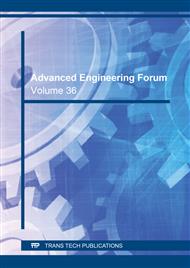p.13
p.23
p.28
p.47
p.59
p.76
p.97
p.114
p.126
A Comparative Study on Performance of Synthetic and Natural Fibers on Compressive and Flexural Strength of Concrete
Abstract:
Ordinary concrete - a stone like structure which is formed by the chemical reaction of the cement, aggregate and water and is a brittle material which is strong in compression but very weak in tension, which causes cracks under small loads. These cracks gradually propagate to the compression end of the member and finally, the member breaks. These increase in size and magnitude with time and finally fails. One of the successful reinforcing methods is providing steel reinforcement but even then, cracks in reinforced concrete members extend freely. Thus, need for multidirectional and closely spaced steel reinforcement arises. Fiber reinforcement gives the solution for this problem. So, to increase the tensile strength of ordinary concrete a technique of introduction of fibers in concrete is being used. These fibers act as crack arrestors and prevent the propagation of the cracks, improves the post cracking response of the concrete, i.e., to improve its energy absorption capacity and apparent ductility, and crack control. The Present study focuses upon, Synthetic (Polypropylene) Fiber Reinforcement (SFRC) of 1% and 3% and Natural (Jute) Fiber Reinforcement (NFRC) of 1% and 3% by weight and are compared with respect to their compressive strength and flexural strength. The present study concludes considering the practical issue of workability of fibers, that in between synthetic and natural fibers selected, 1% Polypropylene fibers can be added as a reinforcement to ordinary concrete to enhance both compressive strength by nearly 2 times at 28 days curing duration and flexural strength by 35%% at 28 days curing duration. History and Development
Info:
Periodical:
Pages:
97-113
Citation:
Online since:
June 2020
Authors:
Price:
Сopyright:
© 2020 Trans Tech Publications Ltd. All Rights Reserved
Share:
Citation:


